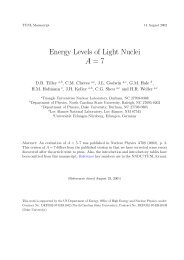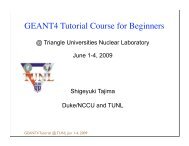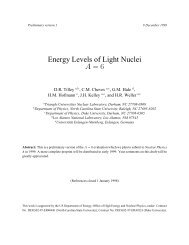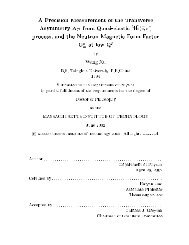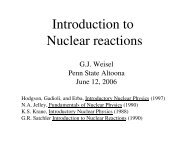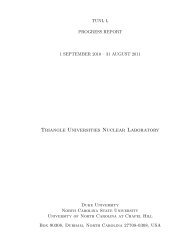Energy Levels of Light Nuclei A = 14 - Triangle Universities Nuclear ...
Energy Levels of Light Nuclei A = 14 - Triangle Universities Nuclear ...
Energy Levels of Light Nuclei A = 14 - Triangle Universities Nuclear ...
Create successful ePaper yourself
Turn your PDF publications into a flip-book with our unique Google optimized e-Paper software.
Observed resonances are displayed in Table <strong>14</strong>.16. The radiative decay is exhibited in Table<br />
<strong>14</strong>.11.<br />
The low-energy capture cross section yields an extrapolated S-factor at E p = 25 keV (c.m.),<br />
S 0 =6.0 ± 0.8 keV· b. The capture cross section rises from (7.7 ± 1.8) × 10 −10 batE p = 100 keV<br />
to (9.8 ± 1.2) × 10 −9 batE p = <strong>14</strong>0 keV: see (70AJ04).<br />
Following is a summary <strong>of</strong> the reasons for the assignments <strong>of</strong> J π ; T to some <strong>of</strong> the lower resonances<br />
displayed in Table <strong>14</strong>.16: for a fuller discussion and complete references see (70AJ04, 76AJ04,<br />
81AJ01). <strong>14</strong> N(7.97): angular distribution <strong>of</strong> the γ-rays is consistent with J π =2 − , <strong>14</strong> N*(8.06):<br />
width <strong>of</strong> resonance, isotropy <strong>of</strong> γ-rays show l p =0;J π =1 − from 13 C(p, p); E1 transition to g.s.<br />
is uninhibited; therefore, T = 1 [but 1.4% 8.06 → 2.31 transition [E x = 2312.6 ± 0.3 keV]shows<br />
T = 0 admixture: α 2 =0.046]. The strong transition 8.06 → 5.69 [3.5%] permits either E1 or<br />
M1, ∆T =1. Since5.69 → 2.31 is seen <strong>14</strong> N*(5.69) cannot have J π =0 + ,and2 + is excluded<br />
by the strength <strong>of</strong> the 8.62 → 5.69 transition. It is then J π =1 − ; T = 0 [the isospin mixing<br />
α 2 =0.09]; E x = 5691.55 ± 0.13 keV (81BI17). <strong>14</strong> N*(8.49, 8.96, 9.13) correspond to anamolies in<br />
the cross section. The nature <strong>of</strong> their γ-decays [see Table <strong>14</strong>.11] and the angular distribution leads<br />
to J π =4 − ,5 + ,3 + [all T = 0], respectively.<br />
<strong>14</strong> N*(8.62) [J π =0 + from 13 C(p, p)] shows strong transitions to <strong>14</strong> N*(0, 3.95, 5.69): T =1.<br />
The strength <strong>of</strong> the 8.62 → 3.95 decay shows it is dipole and therefore J =1for <strong>14</strong> N*(3.95)<br />
[E x = 3947.6 ± 0.4 keV]. The strength <strong>of</strong> the transition 8.62 → 6.20 and the angular correlation<br />
8.62 → 6.20 →g.s. is consistent with J π =1 + , T =0for <strong>14</strong> N*(6.20) [E x = 6203.7 ± 0.6 keV].<br />
<strong>14</strong> N*(8.78) [J π =0 − from 13 C(p, p)] has a large Γ γ consistent with E1 and T =1. <strong>14</strong> N*(9.17):<br />
angular correlation and angular distribution measurements indicate J π =2 + for that state, 3 − for<br />
<strong>14</strong> N*(6.45) [see however Table <strong>14</strong>.10] andJ =2for <strong>14</strong> N*(7.03). For recent studies <strong>of</strong> <strong>14</strong> N*(9.17) see<br />
(81BI17, 86WA13): E x = 9172.5 ± 0.3 keVfromE γ ,Γ γ0 /Γ γ =(79± 4)%, Γ [from (p, p)]= 135 ± 8<br />
eV [135 ± 11 eV in (γ, γ)]. Other E x determined by (81BI17) are 2312.90 ± 0.03, 3948.2 ± 0.2,<br />
5105.9 ± 0.3, and 6446.3 ± 0.2 keV. See also Tables <strong>14</strong>.11 and <strong>14</strong>.<strong>14</strong>.<br />
The angular distribution <strong>of</strong> the γ-rays from 10.23 → 2.31 is consistent with J π = 1 + for<br />
<strong>14</strong> N*(10.23): T = 0 from M 2 (M1) [see, however, Table <strong>14</strong>.10]. The γ 0 angular distribution<br />
is consistent with J =2for <strong>14</strong> N*(10.43): the similar decay characteristics <strong>of</strong> this state and <strong>of</strong><br />
<strong>14</strong> N*(9.17) suggest that they are both J π =2 + , T =1.<br />
Below E p =5.5 MeVonlyγ 0 can be observed in the capture radiation. A number <strong>of</strong> resonances<br />
in the γ 0 yield and in the yield <strong>of</strong> the ground-state γ-rays from 13 C*(3.09, 3.68, 3.85) have been<br />
observed: these are shown in Table <strong>14</strong>.16 in the range E p =3.7 to 6.6 MeV. Angular distributions<br />
and measurements <strong>of</strong> Γ γ0 lead to the J π values shown. Above E p =7MeVtheγ 0 yield shows<br />
broad structure and the giant dipole resonance at E x =22.5 and 23.0 MeV. Measurements <strong>of</strong> the<br />
γ 0 and γ 1 90 ◦ yields for E x =23to33MeVfindthattheT = 2 resonances reported earlier at<br />
E x =23.7 and 24.2 MeV do not exist and that there is no evidence for the T = 2 GDR between<br />
E x = 25 and 29 MeV. The 90 ◦ yields <strong>of</strong> γ-rays to T =0states(4.9



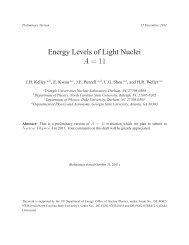

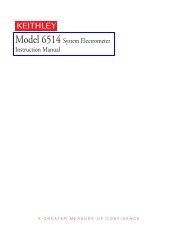
![TUNLXXXIV.tex typeset [1] - Triangle Universities Nuclear Laboratory](https://img.yumpu.com/47618358/1/190x245/tunlxxxivtex-typeset-1-triangle-universities-nuclear-laboratory.jpg?quality=85)
